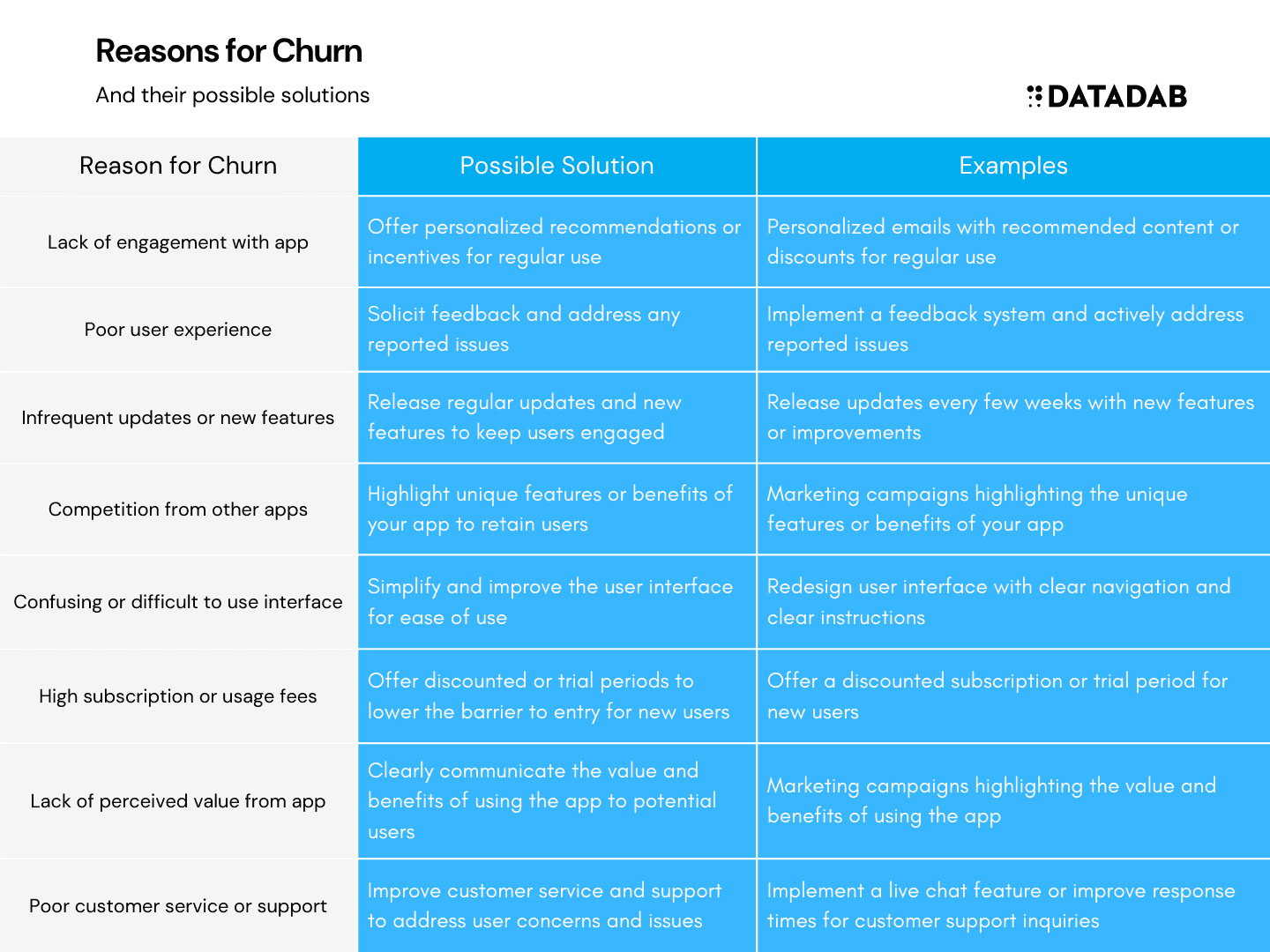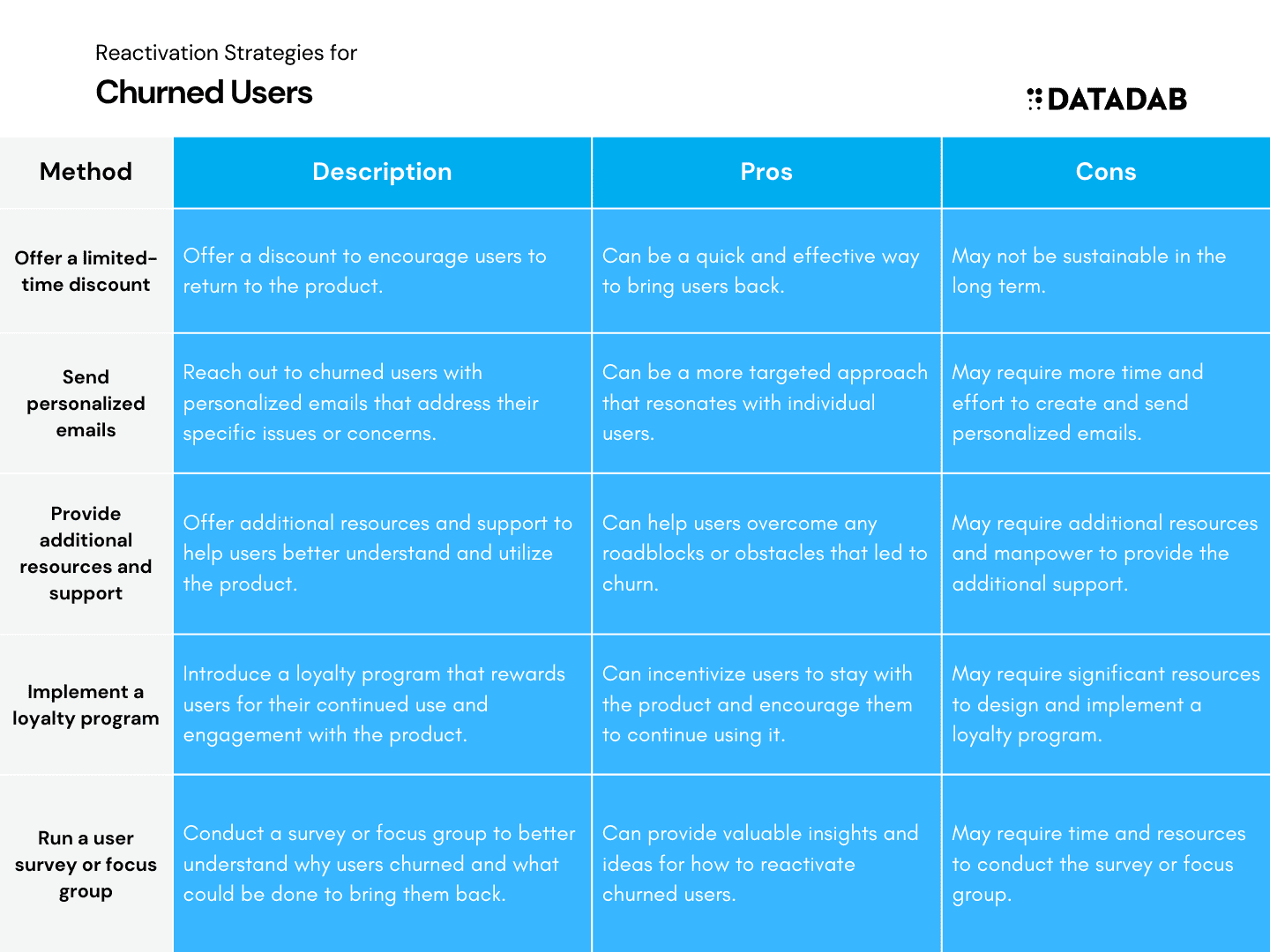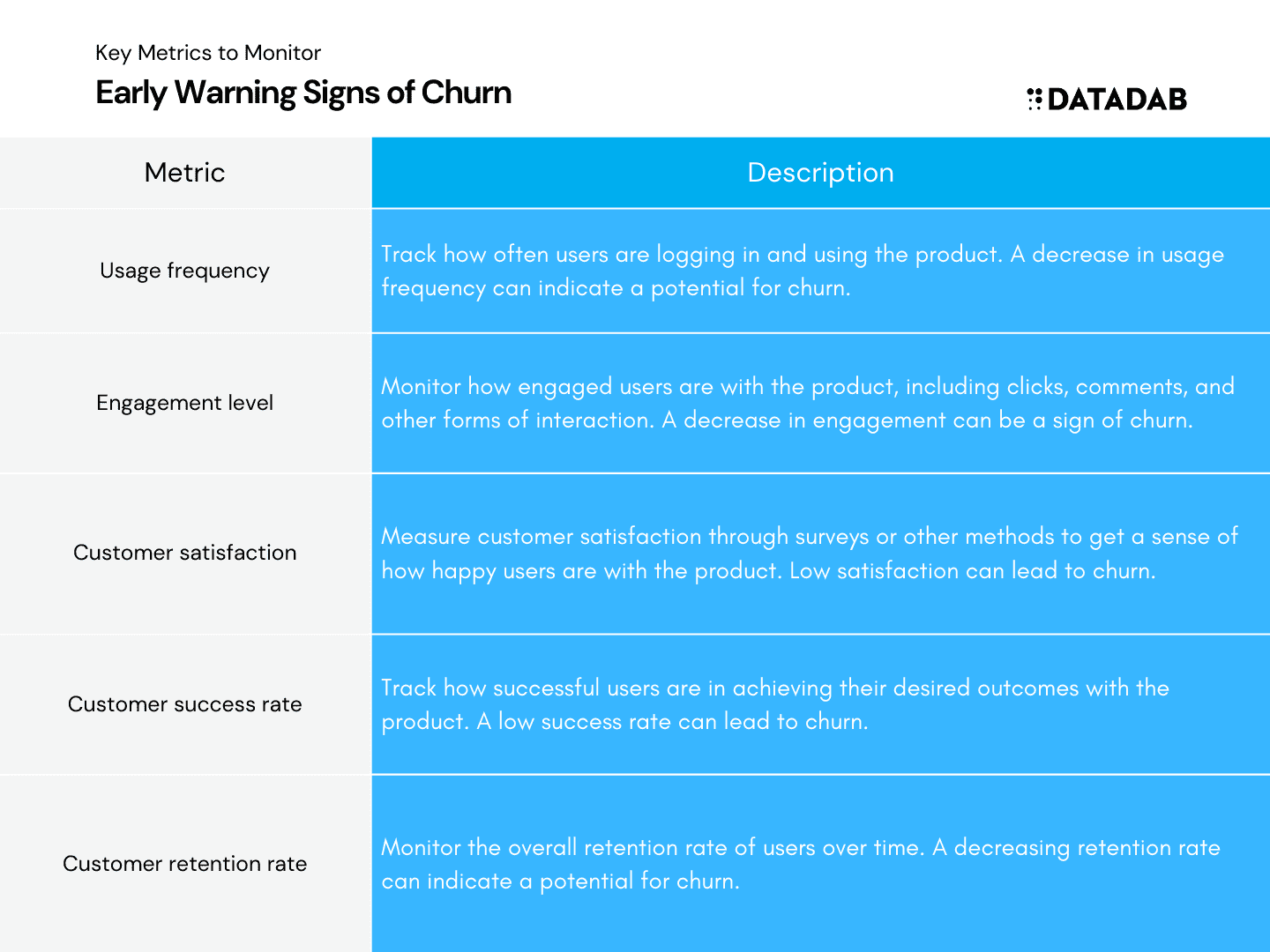"Churn is not just a metric; it's a symptom of a deeper problem. By addressing the root causes of churn, such as poor user experience or inadequate customer support, businesses can prevent churn and build a loyal customer base."
Churn is a common issue among businesses, especially in the digital age. Churn, or customer attrition, refers to when a customer stops using a product or service. This can be a major problem for businesses, as acquiring new customers is often more expensive and time-consuming than retaining existing ones. In fact, research shows that it can cost up to five times more to acquire a new customer than to retain an existing one.

One way to combat churn is to reactivate churned users. This involves reaching out to customers who have stopped using your product or service and enticing them to come back. Reactivating churned users can be a cost-effective way to increase customer retention and ultimately drive more revenue for your business.

But how exactly do you go about reactivating churned users? Here are some strategies and tips to consider:


Identify the reasons for churn
Before you can reactivate churned users, it's important to understand why they stopped using your product or service in the first place. This can help you tailor your outreach efforts and make them more effective.
There are many potential reasons for churn, and they can vary depending on your industry and target audience. Some common reasons include:
To identify the reasons for churn, you can conduct customer surveys or interviews, analyze customer behavior data, or simply ask churned users directly when you reach out to them. This information can help you tailor your reactivation efforts and address any pain points or concerns that may have led to churn in the first place.

Personalized email template
Subject: We noticed you left - anything we could have done better?
Hi [First Name],
I'm [your name], head of customer experience here at [company]. I noticed you recently canceled your subscription with us, and I wanted to check in to see if there was anything we could have done better.
We're always looking to improve our product and service, so if you have any feedback on your experience, I'd love to hear it. Your insights help us create a better product for all our customers.
In the meantime, we'd love to have you back. I've gone ahead and given you [2 months free/50% off your next year/other incentive] in case you'd like to give us another try. Just use code [XXX] at checkout.
Thanks for your time, and please let me know if there's any way I can improve your experience in the future. We appreciate you!
Best, [Your name]
Create a reactivation plan
Once you've identified the reasons for churn, it's time to create a plan for reactivating churned users. This plan should include specific strategies and tactics for reaching out to churned users and convincing them to come back.
Some tactics to consider include:

Reach out to churned users.
Once you have a plan in place, it's time to reach out to churned users and start the reactivation process. You can do this in several ways, depending on your target audience and available resources.
One option is to use email marketing to reach out to churned users. You can create personalized emails that include the incentives or value propositions you've identified in your reactivation plan. You can also segment your email list to make sure you're sending the right messages to the right people. For example, you might send different messages to churned users who left because of a poor user experience than to those who left because they found a better alternative.
Another option is to use social media to reach out to churned users. This can be especially effective if you have a large social media following or if your target audience is active on social media. You can use social media to share updates, promotions, or other content that will pique the interest of churned users and encourage them to come back.
In-app messaging can also be a useful tool for reaching out to churned users. If your product or service is mobile-based, you can use in-app messaging to send personalized messages or offers to churned users. This can be a convenient and targeted way to engage with them and get them to come back.

Monitor and analyze results
Once you've started reaching out to churned users, it's important to monitor and analyze the results of your efforts. This can help you understand what's working and what's not and make adjustments as needed.
To monitor and analyze results, you can use a variety of tools and metrics. For example, you can track the response rate to your outreach efforts, the number of churned users who come back, and the revenue or customer retention rate that results from your reactivation efforts. You can also use customer feedback and surveys to understand better why churned users are coming back and what they value most about your product or service.
Based on this data, you can adjust your reactivation plan and continue refining your strategies and tactics. For example, you might find that offering incentives is more effective than personalized communication or that improving the user experience is key to reactivating churned users. By regularly monitoring and analyzing results, you can continually improve your reactivation efforts and get the most value from them.
Follow up and engage with reactivated users
Once you've successfully reactivated churned users, it's important to follow up and continue engaging with them. This can help you retain them as customers and prevent future churn.
To follow up and engage with reactivated users, you can use a variety of tactics. For example, you can send them regular updates and promotions or offer them additional incentives or rewards. You can also use customer feedback and surveys to understand what they value most about your product or service and make sure you're meeting their needs.
Another important aspect of following up and engaging with reactivated users is providing excellent customer support. This can help ensure that they have a positive experience with your product or service and are more likely to stay loyal customers. You can provide customer support through a variety of channels, such as email, phone, or social media, and make sure that your support team is responsive and helpful.
Reactivating churned users is crucial for any business looking to increase customer retention and drive revenue.
By identifying the reasons for churn, creating a reactivation plan, reaching out to churned users, and monitoring and analyzing results, businesses can effectively reactivate churned users and keep them as loyal customers.
FAQ
1. What is a churned user, and how can I identify them?
A churned user is someone who has stopped using your product or service. There are a few different ways you can identify churned users, depending on the nature of your business:
- Subscription-based businesses: For businesses that rely on monthly or yearly subscriptions, a churned user is someone who has cancelled their subscription or failed to renew it.
- E-commerce businesses: For businesses that sell products online, a churned user is someone who has not made a purchase within a certain timeframe (e.g. 6 months).
- Software businesses: For businesses that offer software products or services, a churned user is someone who has not logged in or used the software within a certain timeframe (e.g. 30 days).
To identify churned users, you'll need to use data analytics tools and track user behavior over time. Look for patterns in user activity, such as declining login frequency or decreased usage of specific features, to determine which users are at risk of churning.
2. Why do users churn, and what can I do to prevent it?
There are many reasons why users may churn, including:
- Lack of value: Users may not see the value in your product or service, or may not have a clear understanding of how it can benefit them.
- Poor user experience: Users may find your product difficult to use or frustrating to navigate.
- Competition: Users may switch to a competitor's product that they perceive as being better or more convenient.
- Pricing: Users may feel that your product is too expensive, or that they can get similar value for a lower cost elsewhere.
- Life events: Users may experience life changes (e.g. moving to a new city, changing jobs) that make your product less relevant to their needs.
To prevent churn, it's important to understand why users are leaving and address those issues directly. Consider sending surveys or conducting user research to gather feedback on your product and identify areas for improvement. You can also offer incentives or rewards to encourage users to stay (e.g. discounts on future purchases, free upgrades to premium features). Finally, make sure you're providing clear and consistent communication with your users to keep them engaged and informed about your product.
3. How can I measure the impact of reactivating churned users on my business?
To measure the impact of reactivating churned users, you'll need to track a few key metrics:
- Conversion rate: This measures the percentage of churned users who return to your product after receiving your reactivation efforts.
- Revenue generated: This measures the amount of revenue generated by reactivated users, both in the short term (e.g. immediate purchases) and long term (e.g. ongoing subscription payments).
- Lifetime value: This measures the total value of a reactivated user over the course of their relationship with your business, including repeat purchases and referrals to other users.
By tracking these metrics, you can determine the ROI of your reactivation efforts and adjust your strategy as needed to maximize their impact.
4. What are some effective strategies for re-engaging with churned users?
You can use various strategies to re-engage with churned users, depending on the nature of your business and why users churned. Some effective strategies include:
- Personalization: Use data analytics tools to personalize your reactivation efforts based on each user's previous behaviors and interests.
- Incentives and offers: Offer discounts, free trials, or other incentives to encourage users to return
- Multi-channel communication: Use a variety of communication channels (e.g. email, social media, retargeting ads) to reach users where they are most likely to engage.
- Clear value proposition: Clearly communicate the value of your product and why it's worth returning to.
- Timing: Timing is critical when attempting to reactivate churned users. Use data analytics tools to determine the best time to send reactivation messages based on each user's previous behavior and engagement patterns.
- Engagement campaigns: Run engagement campaigns to encourage users to engage with your product, even if they're not ready to return right away. For example, you might offer a free trial or demo of a new feature to re-engage users and remind them of your product's value.
- Consistent communication: Consistently communicate with churned users over time to keep them engaged and informed about your product. This might include sending regular newsletters or product updates, or providing helpful resources and tips to encourage users to return.
5. How should I communicate with churned users to encourage them to return?
When communicating with churned users, it's important to be sensitive to their reasons for leaving and provide a clear value proposition for returning. Here are some tips for effective communication:
- Personalization: Use the user's name and tailor the message to their previous behavior and interests.
- Empathy: Show empathy for their reasons for leaving, and let them know that you understand their concerns.
- Clear value proposition: Clearly communicate the value of your product and why it's worth returning to.
- Incentives and offers: Offer discounts, free trials, or other incentives to encourage users to return.
- Call-to-action: Provide a clear call-to-action for users to return to your product, such as a button to reactivate their account or a link to a free trial.
6. What incentives or offers can I provide to encourage churned users to come back?
Incentives and offers can be an effective way to encourage churned users to return to your product. Here are some examples:
- Discounts: Offer a discount on the user's next purchase, or a percentage off their subscription cost for a limited time.
- Free trials: Offer a free trial of a premium feature or product to encourage users to return and see the value of your product.
- Credits or rewards: Offer credits or rewards for returning to your product, such as loyalty points or cashback on purchases.
- Exclusive content: Offer exclusive content or resources to returning users, such as access to premium articles or webinars.
- Upgrade incentives: Offer an upgrade incentive for users who return to your product, such as a free upgrade to a higher-tier subscription level.
7. How can I personalize my approach to reactivating churned users based on their previous behaviors?
Personalization is key when reactivating churned users. Here are some ways you can personalize your approach based on user behavior:
- Segmentation: Use data analytics tools to segment users based on their previous behavior, such as their purchase history, time since last login, or previous interactions with your product.
- Personalized messaging: Tailor your reactivation messages to each user's previous behavior and interests, such as highlighting new features that are relevant to their previous usage patterns.
- Re-engagement campaigns: Create targeted campaigns to re-engage specific user segments, such as users who abandoned their cart or users who haven't logged in for a certain amount of time.
- Incentives and offers: Offer incentives or rewards that are tailored to each user's previous behavior, such as a discount on a product they previously purchased or a free trial of a feature they haven't tried yet.
8. How long should I wait before attempting to reactivate churned users?
The timing of reactivation messages is critical to success. If you wait too long, users may have moved on to a competitor or lost interest in your product altogether. Here are some guidelines for timing reactivation messages:
- Consider user behavior: Use data analytics tools to determine the ideal time to send reactivation messages based on each user's previous behavior and engagement patterns.
- Be timely: Send reactivation messages in a timely manner, ideally within a few days or weeks of the user's last interaction with your product.
- Be consistent: Consistently communicate with churned users over time to keep them engaged and informed about your product. This might include sending regular newsletters or product updates or providing helpful resources and tips to encourage users to return.
9. How do I measure the success of my reactivation campaigns?
Measuring the success of your reactivation campaigns is critical to understanding what works and what doesn't. Here are some metrics to track:
- Conversion rate: Measure the percentage of users who respond to your reactivation campaigns and return to your product.
- Engagement rate: Measure the percentage of users who engage with your reactivation campaigns, such as by opening an email or clicking on a link.
- Revenue generated: Measure the revenue generated by users who return to your product as a result of your reactivation campaigns.
- Lifetime value: Measure the lifetime value of users who return to your product, including their likelihood to make future purchases or refer others to your product.
- Return on investment: Measure the return on investment of your reactivation campaigns, including the cost of the campaign and the revenue generated by returning users.
10. How can I prevent churn in the first place?
Preventing churn is always better than trying to reactivate churned users. Here are some tips for reducing churn:
- Customer support: Offer excellent customer support to help users solve problems and answer questions.
- User feedback: Listen to user feedback and use it to improve your product and address user concerns.
- Product updates: Regularly update and improve your product to keep users engaged and interested.
- Engagement campaigns: Run engagement campaigns to keep users engaged with your product, even if they're not ready to purchase immediately.
- Pricing and packaging: Offer pricing and packaging options that are flexible and appealing to your target audience.
By implementing these strategies, you can reduce the likelihood of users churning in the first place and increase the success of your reactivation campaigns.







